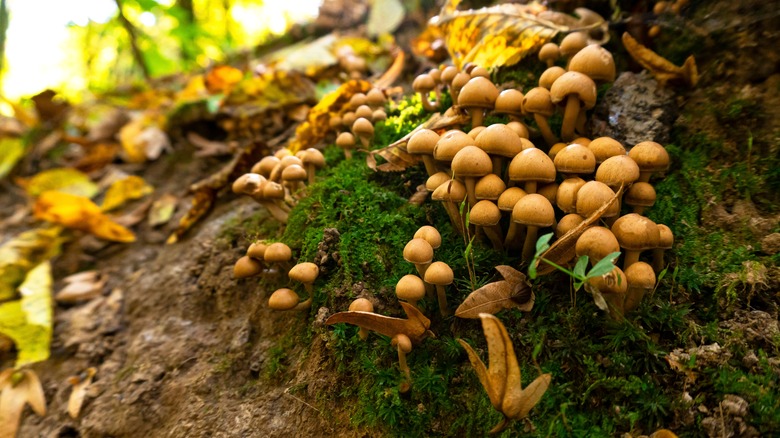Why Researchers Think Some Mushrooms Make Their Own Wind
In his 2008 TEDTalk, mycologist Paul Stamets claims that humans have more in common with networks of fungi — in which millions of different species connect plants, trees, and other living organisms through the internet of forests — than any other kingdom in the natural world. Some mushroom strains have been shown to be effective against viruses while others are being studied as a treatment for depression (via The New York Times). Some strains are deadly, and others are just plain delicious.
One of the most basic things mushrooms do is replicate themselves, but scientists are still uncovering all the ways in which they do so. From underneath the mushroom's cap, millions of microscopic spores measuring roughly 10 microns, which is 1/2, 500th of an inch each, are ejected every day, floating like the fairy dust through the forest before landing on other surfaces and sprouting into new mushrooms (per The New York Times). But, how these tiny organisms manage to explosively eject these spores with enough force so that they don't just float back to the mushroom's stem was a mystery to mycologists for decades, until scientists discovered that mushrooms were actually making their own wind.
The point that cries
Most scientists originally thought that mushrooms relied on chance winds to propel their spores forward into the forest, according to Scientific American. But, one of the world's most prolific mycologists, Arthur Henry Reginald Buller, hypothesized back in the early 1900s that mushrooms often had small drops of water leaking out near the spores at a part of the mushroom anatomy called the punctum lacryman or "the point that cries," per The New York Times. Buller thought the propulsion of the spores was tied to this liquid but didn't get a chance to test his hypothesis in great detail.
So, two other scientists at Duke University picked up where he left off nearly a decade ago. Using ultrafast imaging and computer simulations, they determined that the spores were launched at a complete right angle even when wind was not present to push them along. But, this still wasn't detailed enough to show exactly how the mushrooms shot out their spores.
Fly, spores, fly like the wind
Constructing a plastic model mushroom 10 times larger than real-life mushrooms, the scientists were able to see the mechanism in more granular detail. Using an inkjet printer to model a water droplet at the punctum lacryman, they found the water droplet — which was renamed the Buller's drop for the late scientist — was crucial in the process, as the The New York Times explains. This surface tension between the water droplet and the mushroom creates a convective current that gets the air moving around the mushroom, stirring up "wind" (per Scientific American).
This wind, in a moment that lasts less than a thousandth of a second, shoots out the spores from the mushroom with an explosive bounce, according to The New York Times. It's almost as if the mushroom is a mother, saying goodbye to her child that's finally leaving the nest. It appropriately addresses its grief through the Buller's drop, letting a tear flow before pushing its offspring out from the nest.


